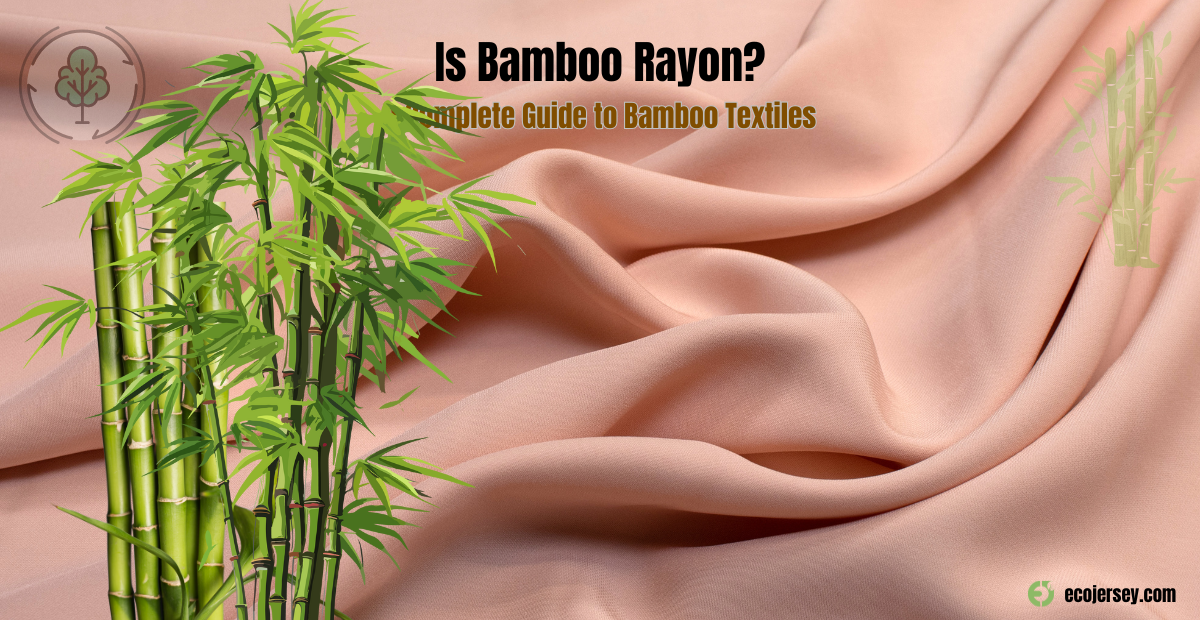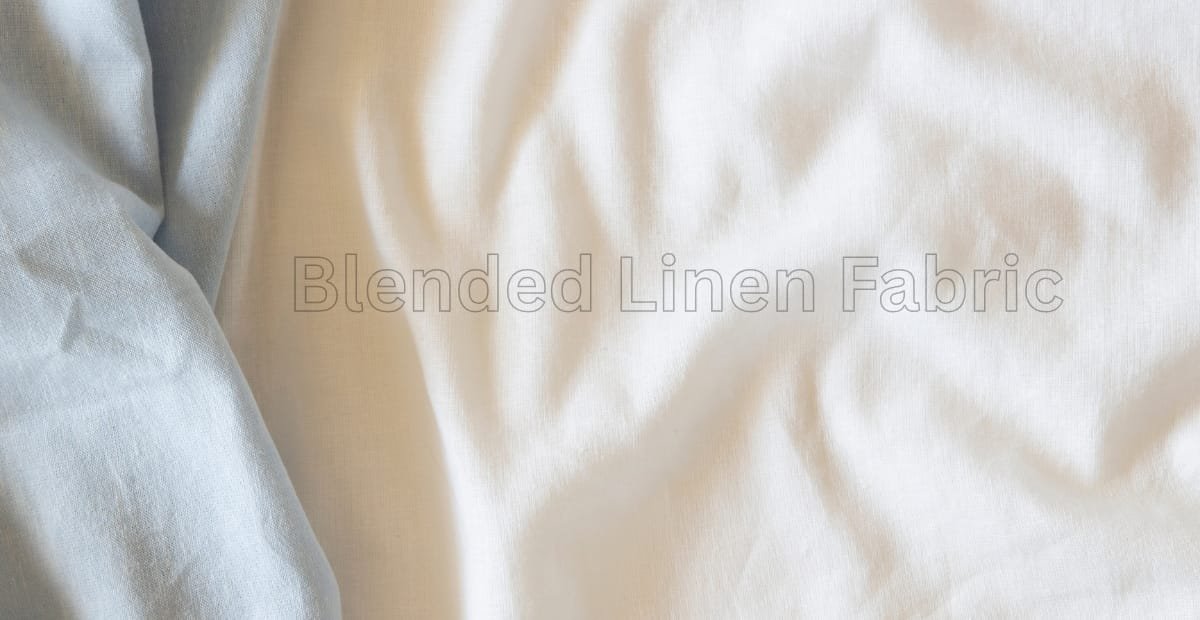Introduction-
The most common question that consumers pose is: Is bamboo rayon? fabric labels can be difficult to understand. Bamboo is used as a green option in the fashion and bedding industry. However, not all of them know that the majority of bamboo textile is rayon.
Bamboo based textiles have become increasingly popular. Out of bamboo sheets to T-shirts they boast to being natural and environmentally friendly. The truth of the matter is however more complicated. As a way of finding the truth, it is necessary to consider what bamboo cloth is actually.
What is Bamboo Fabric?
Natural source: Bamboo plant
Bamboo fabric is made by beginning with the bamboo plant. Bamboo is technically a grass, which has dense woody stalks and powerful fibers. It reproduces very quickly and sprouts once more out of its roots. Indeed, it takes bamboo between 3-5 years to mature and harvest, compared to trees, which take much longer. It also needs very little attention: bamboo stands do not require much additional watering and do not normally need fertilizers and pesticides. Such qualities as rapid growth, high productivity, and low usage make bamboo a sustainable raw material in terms of the reputation.
Sustainable reputation of bamboo
Due to such properties of the plant, bamboo is commonly promoted as eco-friendly. In fact, it is possible to give an example of bamboo, which is more effective in sequestration than numerous hardwoods, and its deep roots make the soil not to erode. Bamboo is cultivated without the need to clear-cut trees (it reproduces through its own root system). This implies that it is possible to avoid deforestation in bamboo farming. In addition, bamboo plots produce large amounts of biomass using comparatively low amounts of water.
These facts make bamboo as a material source to have a green image. One thing to keep in mind, however, is that these advantages have to do with the plant as well. After bamboo has been made into a fabric, numerous benefits of nature may be lost in processing.
Types of bamboo fabric (mechanical vs chemical)
Mechanically Processed Bamboo (Bamboo Linen):
- Prepared by crushing bamboo stalks and the natural enzymes.
- This is done by combing out and spinning into fibers into the yarn, like linen.
- It is a very rough textured fabric and at the same time very strong.
- Uncommon in the market since it is a labor-intensive process that is expensive.
Chemically Processed Bamboo (Bamboo Rayon/Viscose):
- The manufacture is through the dissolution of bamboo pulp in harsh chemical solvents.
- The silky fibers of the cellulose solution are spun.
- This type takes the lead of the market as it is the cheapest to manufacture. Soft, smooth and cheap yet not so environmental-friendly.
Bamboo Lyocell (Eco-Friendly Alternative):
- Utilises closed loop process using non-toxic solvents.
- The reuse of chemicals helps them to lessen the damage on the environment.
- Gives the result of a soft, breathable and strong fabric. The most sustainable choice of bamboo fabric.
What is Rayon (Viscose)?
Definition: Semi-synthetic cellulose fiber
Rayon, or viscose as it is sometimes called, is a semi-synthetic fiber, comprised of natural cellulose. That is, it begins with plant cellulose (wood, cotton, or bamboo pulp) and is converted to fiber through human-developed procedures. Rayon is actually an artificial silk, invented technically and thus it is very smooth. Rayon, however, is not a completely natural fiber, despite a little marketing. According to one source, rayon is commonly regarded as a natural fiber, though in fact, it is a substance made of cellulose that needs a lot of chemical work. Bamboo rayon fibers may resemble cotton or silk in their feel, and it is why clothes made of bamboo rayon may feel so soft.
How rayon is produced (chemical process)
Rayon production is a complicated process, which consists of various chemical reactions. Firstly, it prepares pulp of cellulose (wood or bamboo) and combines it with caustic soda (sodium hydroxide). Then a chemical compound known as carbon disulfide is incorporated which transforms the cellulose into a thick liquid. This solution of viscose is then pumped through spinnerets (small holes) into an acid bath. The solution becomes solid in the acid in fine filaments of regenerated cellulose. These filaments are washed, neutralized, and spinned into yarn. More importantly, the process involves toxic chemicals (carbon disulfide and strong acids, in particular), which may be harmful to the environment and human health when they escape.
Common uses in fashion and textiles
Rayon is valued because of its silk characteristics hence it is extensively applied in textiles. For example:
- Clothing: Rayon is used in dresses, blouses, t-shirts, sleepwear and underwear. It is a great-looking drape, and cool to the touch. Bamboo rayon T-shirts and leggings are known as having a smooth, stretchy feel.
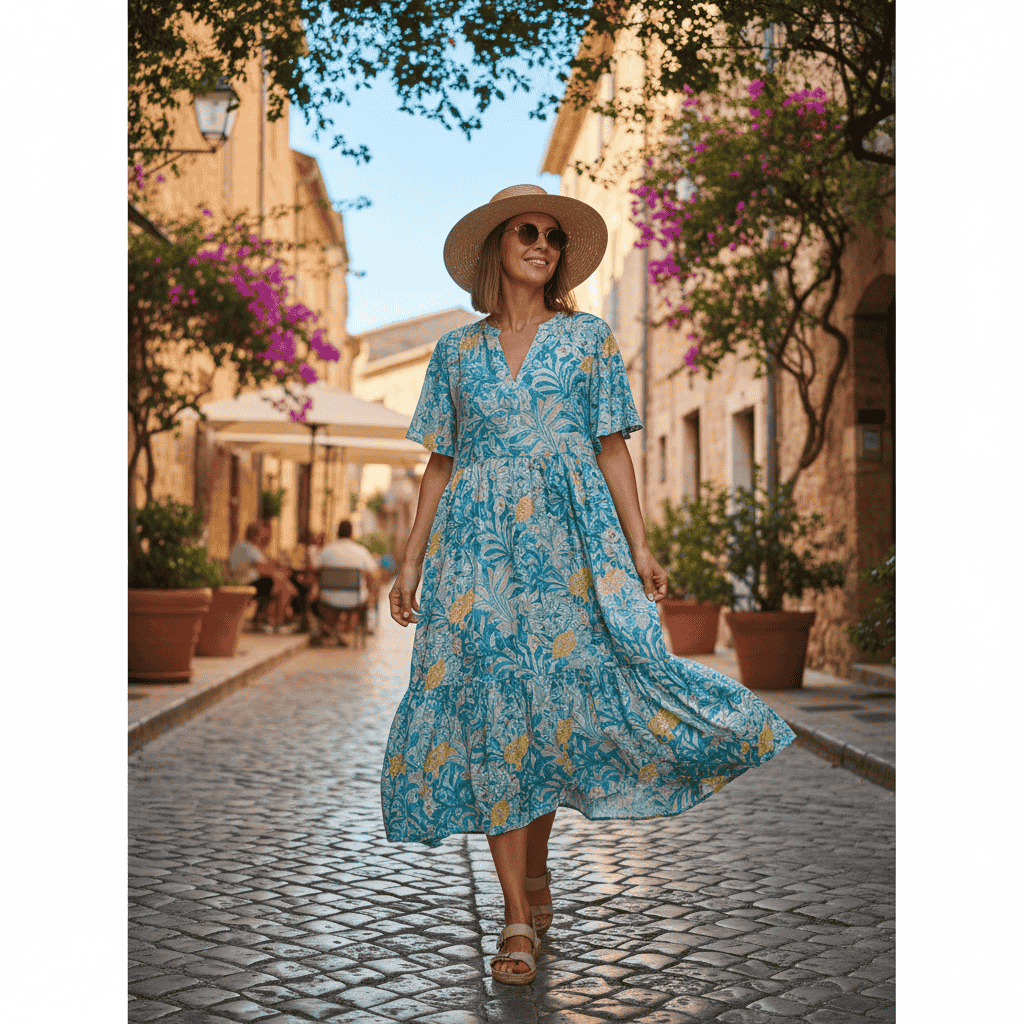
- Home textiles: Rayon could be applied in bed clothing (sheets, pillowcases), towels, and upholstery to provide a touch. Numerous bamboo sheets available in the market are actually bamboo rayon sheets, and are touted as soft and breathable.
- Medical: Rayon is a good absorber of liquids, and it is soft; hence it is used in bandages, surgical dressing, and wiping. Hygiene items and bamboo rayon bandages take advantage of its softness. As an example, bamboo rayon is utilized in medical gauze and even baby wipes.
- Blended fabrics: Rayon is frequently blended with cotton, or even synthetic fibers. Some types of fabrics can resemble linen or wool, and will offer a silky touch at a lower price. Even it is mixed into denim or leisure wear to be even more comfortable.
Is Bamboo Rayon?
Yes -Bamboo fabric is generally rayon. The reality is, that the majority of products sold as bamboo are bamboo viscose/rayon. This implies that it is not bamboo fiber made by the stalk but by regeneration of bamboo cellulose. Even the regulatory bodies have intervened to curb false labellings. As an example, U.S and Canadian law dictates that such textiles should be labeled as rayon, bamboo, and not bamboo. Practically, where you find a bamboo T-shirt or sheets, it is usually bamboo rayon. Authentic mechanical bamboo fiber cloth (bamboo linen) is very rare and it is normally sold at a very high price.
Different Types of Bamboo Fabrics
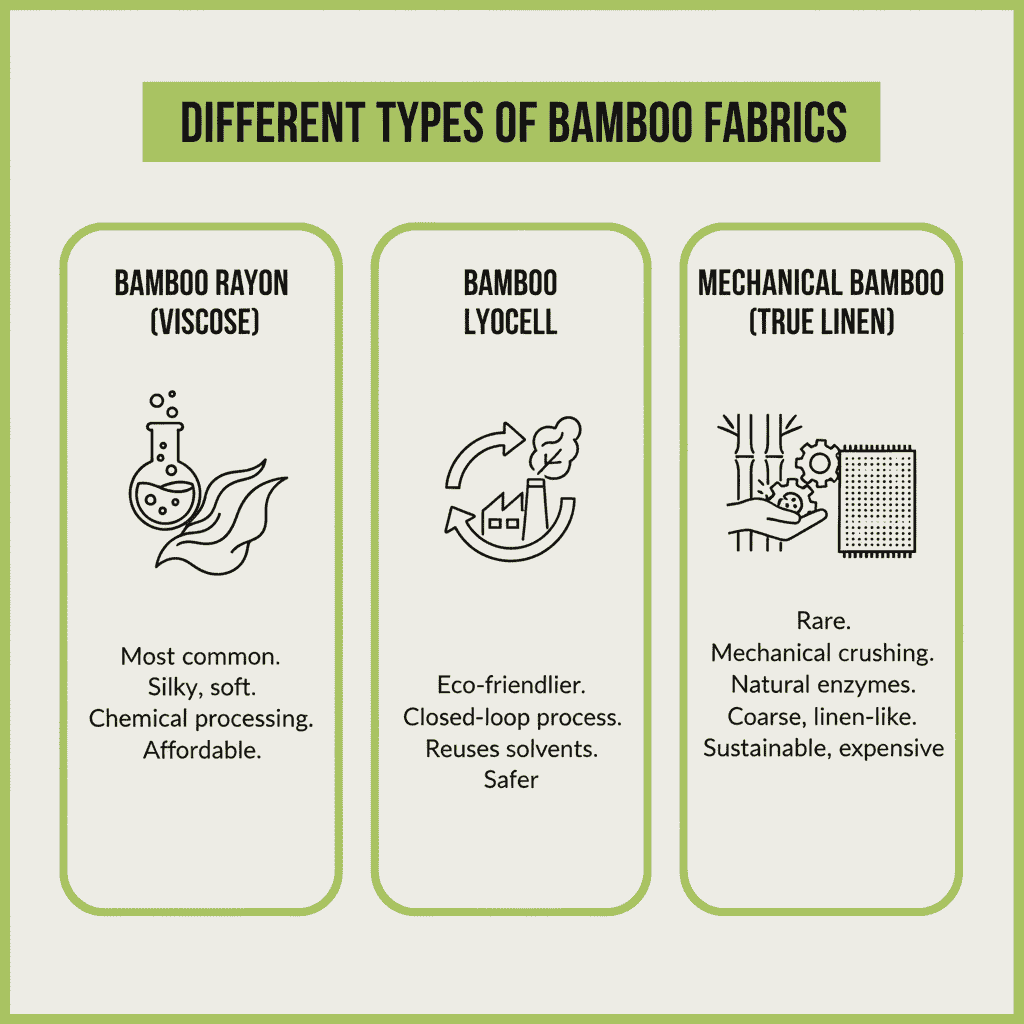
Bamboo Rayon (Viscose)
This is the most popular type of bamboo textile. Bamboo rayon (or bamboo viscose) is fabrics that are manufactured after chemically treating bamboo pulp into fibers. The resultant product is a smooth, silky fabric. Bamboo rayon tends to be extremely soft and luxurious–softer than rough linen. It is loose fitting and flows well. As a matter of fact, bamboo rayon is more comfortable to many people than ordinary cotton. Nevertheless, keep in mind that bamboo rayon is made by using harsh chemicals. The smooth material is a sacrifice to that chemical footprint.
Bamboo Lyocell (TENCEL™)
Bamboo lyocell is a more environmentally-friendly type of bamboo. It employs another production process. It replaces the old viscose chemicals with non-toxic solvent in a closed loop process. Almost all (approximately 99.5 percent) of the solvent is reused. What has been made is a soft, durable fiber quite like rayon to feel. It is frequently marketed as brand names such as TENCEL™. The closed cycle process implies a lot less pollution. Bamboo lyocell in a nutshell is Bamboo rayon with much cleaner chemistry.
Mechanical Bamboo (True Bamboo Linen)
Authentic bamboo fiber (bamboo linen) is made in a mechanical way. The stalks of bamboo are pounded and retted (usually with enzymes) and the long fibers are pulled out either manually or mechanically. This is then spun into yarn. That process does not require any harsh solvents, hence it is entirely natural. The resulting fabric is rough and slightly textured (similar to flax linen). Bamboo linen is cool, absorbent and not that stretchy or silky. The mechanical process is labor-intensive making the bamboo linen costly and not commonly found. When you see the designation “bamboo fiber” (without viscose) on clothing, it is probably this bamboo linen, and it will not be as smooth as rayon.
How Bamboo is Turned Into Rayon: Step-by-Step Process
The general procedures of making bamboo a viscose rayon include:
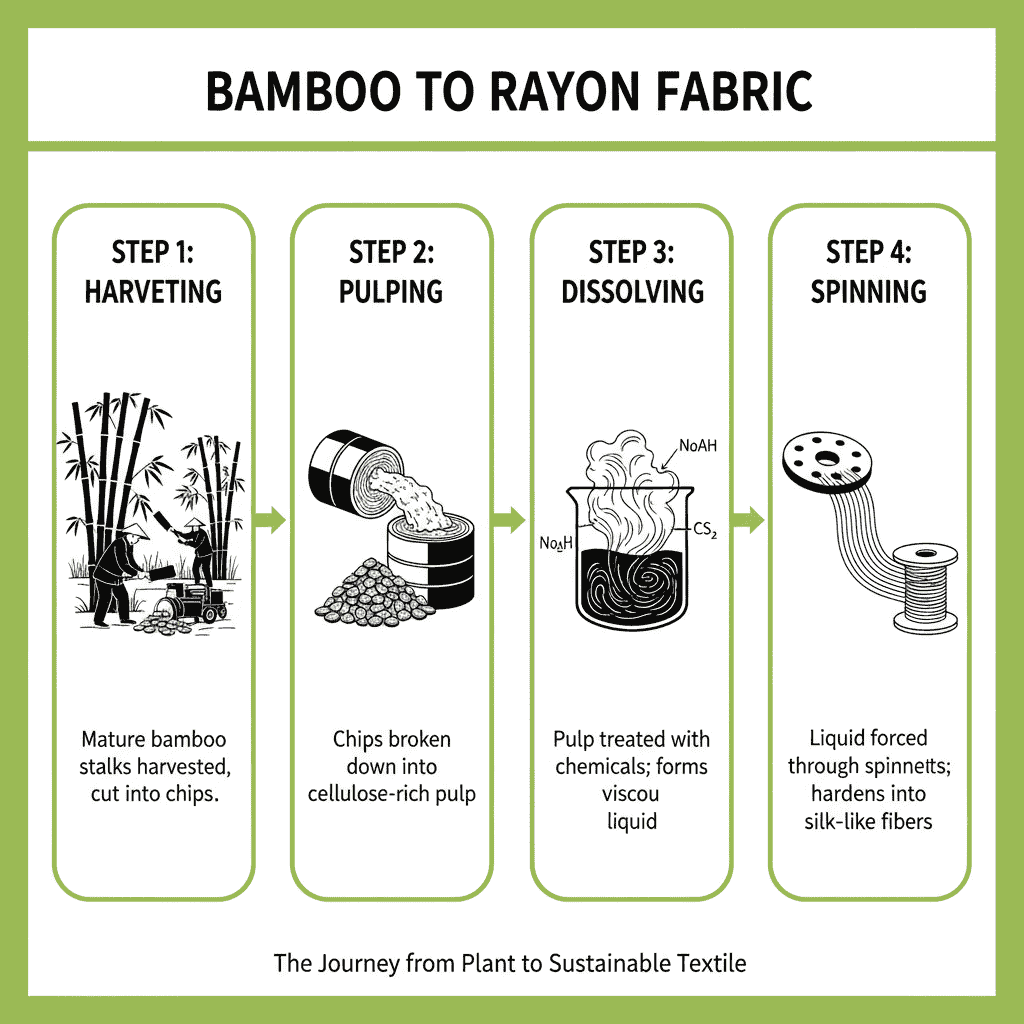
- Bamboo harvesting: Stalks of the bamboo are mature and are cut down and chipped. The chips are washed and ready. (At this stage fibers may be combed (in the mechanical process), but in the case of rayon, we pass to chemical pulping).
- Production of Bamboo Pulp: The bamboo chips are boiled or cooked in a high solution of sodium hydroxide. This decomposes lignin and hemicellulose, and leaves primarily cellulose. A wet bamboo cellulose pulp is left after washing.
- Chemical Dissolution: It is followed by the addition of carbon disulfide to the purified cellulose pulp and the resulting compound is known as cellulose xanthate. The solution undergoes another dissolution in further sodium hydroxide to produce a viscous liquid ( hence viscose ). It is a very toxic step: carbon disulfide is toxic and flammable, and the chemicals have to be dealt with carefully.
- Spinning Fibers: The viscose solution is filtered, and then the solution press is pumped through small holes (spinneret) into an acid bath. The cellulose is again solidified into filaments in the acid. The filaments are extracted, rinsed and dried. They are lastly spun into yarn. It is this yarn that is woven or knitted to make bamboo rayon cloth.
Pros of Bamboo Rayon: Why People Love It
Soft and Silky Touch: Bamboo rayon is smooth as cotton or silk.
Lightweight and Breathable: It is lightweight and breathable, which makes it perfect to wear in summer.
Affordable: It is soft luxuriously and cheaper than silk or linen.
Cons of Bamboo Rayon: Drawbacks to Consider
Heavy Chemical Processing is needed: It involves the use of toxic chemicals which may damage the environment.
Not as Sustainable as Advertised: Bamboo rayon, although being promoted as environmentally friendly, has its dark side.
Durability Issues: It is less strong when it is wet and it is easily wrinkled.
Bamboo Rayon vs Other Fabrics
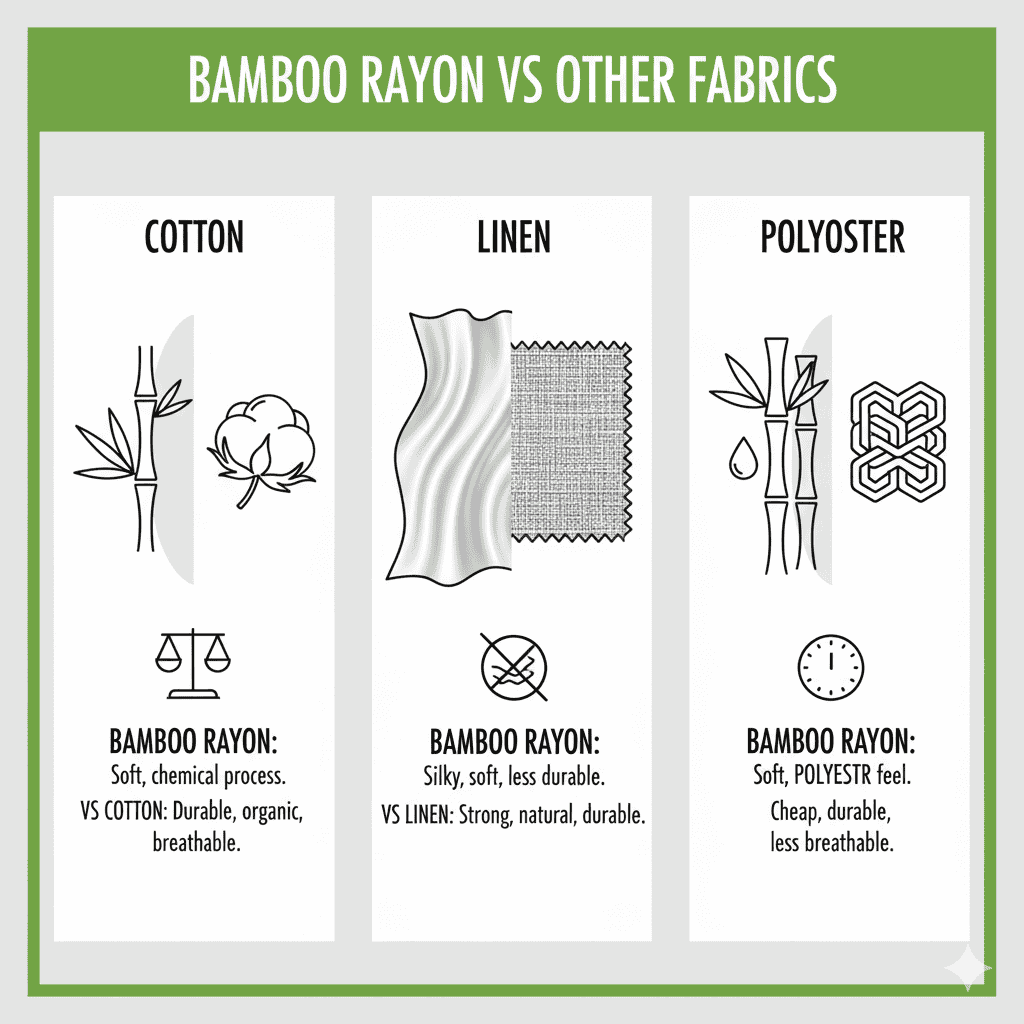
Bamboo Rayon vs Cotton
Both bamboo rayon and cotton are soft and breathable, but have varying strengths. Bamboo rayon is more smooth and silky than cotton. It is loose fitting and it may be cooler to the touch. As a matter of fact, bamboo rayon is said to be just as breathable, or more so, as cotton. But cotton is more resilient: it can withstand higher temperatures during washing and it is likely to increase its strength each time it is washed.
Traditional methods of cotton growing consume large quantities of water and occasionally pesticides, but bamboo consumes less water and no pesticides. However, keep in mind that the fabrication of bamboo to rayon requires the use of harsh chemicals, whereas cotton fiber is natural.
Bamboo Rayon vs Linen
Linen (of flax) is very powerful and hard. Bamboo rayon, in its turn, is much smoother and softer. Linen can be hard before being washed a couple of times, bamboo rayon is soft immediately. Linen is also incredibly tough- as much tougher than cotton- and bamboo rayon is not much more than twice as tough as cotton at best.
Therefore, linen clothes can be used over decades, but bamboo rayon clothes may be shorter lived. Linen is airy and it cools down just like rayon. Linen also wrinkles quite easily (some consider that a virtue), but bamboo rayon is wrinkle-resistant. Lastly, linen tends to be costlier because it is processed in a laborious manner whereas bamboo rayon is cheaper. So: Bamboo rayon is more silky; linen is more coarse and durable.
Bamboo Rayon vs Polyester
Polyester is an entirely synthetic fiber produced out of petroleum. It is highly strong, inexpensive and non-wrinkle; however, it is not breathable. In comparison, bamboo rayon is naturally cooling and moisture-wicking. Polyester is also known to trap heat and it might feel clammy where as Bamboo rayon keeps you cooler. Polyester is tough and low-maintenance (it does not shrink or dry up too fast). But polyester cannot be called environmentally friendly: it releases microplastics and is not biodegradable. The positive feature of bamboo rayon is its comfort: it is more natural and soft to touch the skin. Naturally, both cannot be called ecologically ideal, however, bamboo rayon (plant-based) can be more biodegradable in comparison with polyester.
| Property | Bamboo Rayon | Cotton | Linen | Polyester |
|---|---|---|---|---|
| Softness | Very soft, silky | Soft, becomes softer | Initially coarse, softens | Smooth, not silken |
| Breathability | High (wicking, cool) | High | High | Low (traps heat) |
| Durability | Moderate (weaker when wet) | Good | Excellent | Excellent |
| Eco-Impact | Medium (toxic process) | Low (water & pesticide use) | High (minimal inputs) | Low (petroleum-based) |
| Cost | Moderate (affordable) | Moderate | Higher (premium) | Low (mass-produced) |
Is Bamboo Rayon Eco-Friendly?
Misleading “Eco” Marketing
- Multiple brands promote bamboo rayon as natural or green fabric.
- Although the bamboo crop is fast growing and requires less water, the production of rayon is a chemical-intensive process.
- Such terms as eco-bamboo usually conceal the truth of factory work.
- Customers should not trust what the marketing says but seek to know the actual impact.
Environmental Impact of Chemical Processes
- The process of manufacture of rayon requires the utilization of harsh chemicals like sodium hydroxide and carbon disulfide.
- Where it is not managed properly it can lead to water pollution.
- Employees in ill-managed factories are exposed to risks on health due to chemicals.
- The process decreases the natural eco-advantages of bamboo making it less sustainable.
Better Alternatives
- Bamboo Lyocell: It uses the safer solvents in a closed recycled system solvent.
- Organic Cotton: This is cultivated without the use of pesticides that are dangerous to the environment, and is therefore safer to the soil and farmers.
- Hemp: Hardy, naturally pest-resistant and need minimum use of water to grow.
How to Identify Genuine Bamboo Rayon Products
- Looks in Fabric Labels: Find “viscose from bamboo” or “rayon from bamboo.”
- Certifications: OEKO-TEX, or USDA Organic certifications.
- Price/ Quality Red Flags: There is very cheap bamboo products that tend to be Rayon of very low quality.
Conclusion-
Bamboo rayon is a mixed bag. On the one hand, it offers you a fabulously smooth, silky and breathable fabric at an affordable price. It can be wonderful to use as snug bedding, lingerie or summer wear. Conversely, it is not the green wonder it is being sold as. The production of it is toxic and its sustainability is overstated.
To conclude, purchase bamboo rayon in case you value comfort and cost-effectiveness and the brand is transparent about its activities. It’s worth it for the feel. However, when it comes to being environmentally friendly, you should use some other options such as organic cotton, linen, hemp, or bamboo lyocell. Those fibers are more environmentally-friendly farm to fabric. Always examine labels and certifications and make the most knowledgeable decision. I hope the question “Is Bamboo Rayon?” has solved.
Read More>> About what is rayon fabric?
FAQs
Is bamboo rayon natural or synthetic?
Bamboo rayon is semi synthetic. It begins with a natural plant (bamboo) though it is very heavily processed with chemicals. It is technically a regenerated cellulose fiber not a raw natural fiber.
Is bamboo rayon the same as viscose?
Yes. Bamboo rayon and bamboo viscose are the same thing, both are made of bamboo cellulose which makes rayon.
Is bamboo rayon breathable for summer?
Generally, yes. Bamboo rayon materials are rather breathable and wicking. They are more comfortable in hot weather and will allow air to move and sweat will evaporate.
Is bamboo rayon better than cotton?
It is a matter of priorities. Bamboo rayon tends to be softer, silkier and absorbs moisture well, and the cotton is stronger, durable and it is easy to wash. Both have problems environmentally (cotton is water intensive; bamboo rayon is treated with harsh chemicals). Bamboo rayon can be more comfortable, whereas cotton is better in terms of durability and consideration.
Does bamboo rayon shrink?
When not correctly washed, bamboo rayon may shrink. Similar to other types of viscose, it is prone to heat and agitation. Wash it in cool or lukewarm water and dry it by air in order to reduce the shrinkage. It can be shrunk or stretched by high heat, or rough washing. It is best to always use the label on the care.

